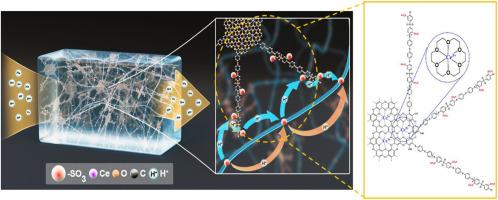含有与铈离子配位的磺化聚(芳烯硫醚砜)接枝二维冠醚框架的碳氢化合物基复合膜,用于 PEMFC 应用
IF 9
1区 工程技术
Q1 ENGINEERING, CHEMICAL
引用次数: 0
摘要
我们提出了一种开发磺化聚(芳基醚砜)(SPAES)复合膜的新策略,该策略可同时提高 PEMFC 应用中碳氢化合物基膜的理化稳定性和质子传导性。这一策略包括使用与铈3+离子配位的磺化聚(芳基硫醚砜)接枝二维冠醚框架(SATS-C2O-Ce)作为一种有前景的填充材料。SATS-C2O 是一种高度磺化的聚合物接枝二维框架,其骨架结构中含有冠醚孔,制备方法是使用卤代氯代葡萄糖醇作为多功能构建单元自缩合形成 C2O,然后使用 SATS 缩合将磺化聚合物接枝到其边缘。通过使用 Ce 水溶液进行简单的掺杂处理,Ce3+ 离子直接配位在 SATS-C2O 的冠醚孔中。含有 SATS-C2O-Ce 的 SPAES 复合膜(SPAES/SATS-C2O-Ce)具有优异的尺寸稳定性和机械韧性。与原始 SPAES 和 SPAES/Ce(含有相同数量的 Ce3+ 离子,但不含 SATS-C2O)相比,SPAES/SATS-C2O-Ce 具有出色的化学稳定性,这要归功于 Ce3+ 离子在 SPAES 基质中的良好分散状态。此外,SPAES/SATS-C2O-Ce 的质子传导性超过了原始 SPAES、SPAES/C2O 和 SPAES/Ce,这是因为 SATS-C2O-Ce 的磺酸基团提供了额外的质子传导通道,同时 SPAES 的吸水能力也得到了提高。本文章由计算机程序翻译,如有差异,请以英文原文为准。

Hydrocarbon-based composite membranes containing sulfonated Poly(arylene thioether sulfone)-grafted 2D crown ether framework coordinated with cerium ions for PEMFC applications
We propose a novel strategy to develop sulfonated poly(arylene ether sulfone) (SPAES) composite membranes that can simultaneously improve the physicochemical stability and proton conductivity of hydrocarbon-based membranes for PEMFC applications. This strategy involves the use of a sulfonated poly(arylene thioether sulfone)-grafted 2D crown ether framework coordinated with cerium3+ ions (SATS–C2O–Ce) as a promising filler material. SATS-C2O, a highly sulfonated polymer-grafted 2D framework containing crown ether holes in its skeletal structure, was prepared via self-condensation using halogenated phloroglucinol as a multifunctional building unit to form C2O, followed by condensation using SATS to graft the sulfonated polymer onto its edge. Ce3+ ions were directly coordinated within the crown ether holes of SATS-C2O via a simple doping process using aqueous Ce solution. The SPAES composite membranes containing SATS–C2O–Ce (SPAES/SATS–C2O–Ce) exhibited exceptional dimensional stability and mechanical toughness. The remarkable chemical stability of SPAES/SATS–C2O–Ce compared to that of pristine SPAES and SPAES/Ce (containing the same amount of Ce3+ ions but without SATS-C2O) was attributed to the well-dispersed state of Ce3+ ions within the SPAES matrix. Furthermore, the enhanced proton conductivity of SPAES/SATS–C2O–Ce surpassed those of pristine SPAES, SPAES/C2O, and SPAES/Ce by the formation of additional proton-conducting channels provided by the sulfonic acid groups of SATS–C2O–Ce, along with the improved water uptake capability of SPAES.
求助全文
通过发布文献求助,成功后即可免费获取论文全文。
去求助
来源期刊

Journal of Membrane Science
工程技术-高分子科学
CiteScore
17.10
自引率
17.90%
发文量
1031
审稿时长
2.5 months
期刊介绍:
The Journal of Membrane Science is a publication that focuses on membrane systems and is aimed at academic and industrial chemists, chemical engineers, materials scientists, and membranologists. It publishes original research and reviews on various aspects of membrane transport, membrane formation/structure, fouling, module/process design, and processes/applications. The journal primarily focuses on the structure, function, and performance of non-biological membranes but also includes papers that relate to biological membranes. The Journal of Membrane Science publishes Full Text Papers, State-of-the-Art Reviews, Letters to the Editor, and Perspectives.
 求助内容:
求助内容: 应助结果提醒方式:
应助结果提醒方式:


